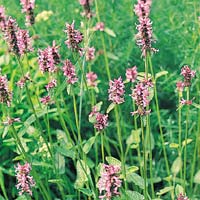Penn Herb Wellness Guide
Wood BetonyFind Products
 © Martin Wall
© Martin WallParts Used & Where Grown
Native to Europe, wood betony is now planted in many parts of the world with temperate climates. The primary portions of the plant that are used as medicine are the leaves and flowers, though historically the root has also been used. There are many similar species originating from Eurasia, including Stachys sieboldii (Chinese artichoke, kan lu) and S. atherocalyx (hedge nettle).
- Reliable and relatively consistent scientific data showing a substantial health benefit.
- Contradictory, insufficient, or preliminary studies suggesting a health benefit or minimal health benefit.
- For an herb, supported by traditional use but minimal or no scientific evidence. For a supplement,little scientific support.
Our proprietary “Star-Rating” system was developed to help you easily understand the amount of scientific support behind each supplement in relation to a specific health condition. While there is no way to predict whether a vitamin, mineral, or herb will successfully treat or prevent associated health conditions, our unique ratings tell you how well these supplements are understood by the medical community, and whether studies have found them to be effective for other people.
For over a decade, our team has combed through thousands of research articles published in reputable journals. To help you make educated decisions, and to better understand controversial or confusing supplements, our medical experts have digested the science into these three easy-to-follow ratings. We hope this provides you with a helpful resource to make informed decisions towards your health and well-being.
This supplement has been used in connection with the following health conditions:
| Used for | Amount | Why |
|---|---|---|
Anxiety | Refer to label instructions | Wood betony is one of a group of “nerve tonic” (nervine) herbs used in traditional herbal medicine for people with anxiety, with few reports of toxicity.
|
Common Cold and Sore Throat | Refer to label instructions | Traditional Chinese Medicine practitioners use Chinese artichoke, a species similar to wood betony, for colds and flu. |
Gastritis | Refer to label instructions | Wood betony has been used in European traditional herbal medicine for the treatment of heartburn and gastritis. |
Shingles and Postherpetic Neuralgia | Refer to label instructions | Wood betony is a traditional remedy for various types of nerve pain and may be helpful for postherpetic neuralgia. |
Sinusitis | 900 mg per day of diosmin and 100 mg per day of hesperidin | Wood betony is used in traditional European herbal medicine as an anti-inflammatory remedy for people with sinusitis. |
Traditional Use (May Not Be Supported by Scientific Studies)
Wood betony was used in European folk herbalism as a remedy for respiratory tract inflammation, heartburn, urinary tract inflammation, varicose veins, intestinal worm infestations, and failure to thrive.1 It was considered a calming remedy and was used for headaches as well as some forms of neuralgia, including shingles.2
Copyright 2026 TraceGains, Inc. All rights reserved.
Learn more about TraceGains, the company.
The information presented by TraceGains is for informational purposes only. It is based on scientific studies (human, animal, or in vitro), clinical experience, or traditional usage as cited in each article. The results reported may not necessarily occur in all individuals. Self-treatment is not recommended for life-threatening conditions that require medical treatment under a doctor's care. For many of the conditions discussed, treatment with prescription or over the counter medication is also available. Consult your doctor, practitioner, and/or pharmacist for any health problem and before using any supplements or before making any changes in prescribed medications. Information expires December 2026.


